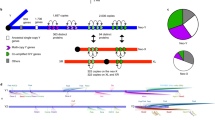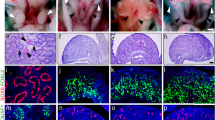Abstract
SEX in Caenorhabditis elegans is determined by a regulatory cascade of seven interacting autosomal genes controlled by three X-linked genes in response to the X chromosome-to-autosome (X/A) ratio1,2. XX animals (high X/A) develop as self-fertile hermaphrodites, and XO animals (low X/A) develop as males. The activity of the first gene in the sex-determining cascade, her-1, is required for male sexual development3. XO her-l loss-of-function mutants develop as self-fertile hermaphrodites, whereas XX her-l gain-of-function mutants develop as masculinized intersexes4. By genetic mosaic analysis using a fused free duplication linkingher-l to a cell-autonomous marker gene, we show here thather-lexpression in a sexually dimorphic cell is neither necessary nor sufficient for that cell to adopt a male fate. Our results suggest thather-l is expressed in many, possibly all, cells and that its gene product can function non-autonomously through cell interactions to determine male sexual development.
This is a preview of subscription content, access via your institution
Access options
Subscribe to this journal
Receive 51 print issues and online access
$199.00 per year
only $3.90 per issue
Buy this article
- Purchase on Springer Link
- Instant access to full article PDF
Prices may be subject to local taxes which are calculated during checkout
Similar content being viewed by others
References
Hodgkin, J. in The Nematode Caenorhabditis elegans (ed. Wood, W. B.) 243–280 (Cold Spring Harbor Laboratory, New York, 1988).
Meyer, B. Trends Genet. 4, 337–342 (1988).
Hodgkin, J. Genetics 96, 649–664 (1980).
Trent, C., Wood, W. B. & Horvitz, H. R. Genetics 120, 145–157 (1988).
Hodgkin, J. A. Rev. Genet. 21, 133–154 (1987).
Hunter, C. P. & Wood, W. Cell 63, 1193–1204 (1990).
Schedin, P., Hunter, C. P. & Wood, W. B. Development 112, 833–879 (1991).
Villeneuve, A. M. & Meyer, B. J. Genetics 124, 91–114 (1990).
Sulston, J. & Horvitz, H. R. Devl Biol. 56, 110–156 (1977).
Kimble, J. & Hirsh, D. Devl Biol. 70, 396–417 (1979).
Sulston, J. E., Schierenberg, E., White, J. G. & Thomson, J. N. Devl Biol. 100, 64–119 (1983).
Hodgkin, J. J. Embryol. exp. Morph. 83, 103–117 (supplement) (1984).
Schauer, I. & Wood, W. B. Development 110, 1303–1317 (1990).
Schedin, P. thesis, Univ. Colorado (1988).
Hodgkin, J. Nature 344, 721–728 (1990).
McLaren, A. Trends Genet. 4, 153–157 (1988).
Patek, C. E. et al. Development 115, 311–325 (1991).
Rosenbluth, R., Cuddeford, C. & Baillie, D. L. Genetics 109, 493–511 (1985).
O'Brien, S. J. (ed) Genetic Maps 5, 3.111–3.133 (Cold Spring Harbor Lab., New York (1990)).
Herman, R. K., Albertson, D. G. & Brenner, S. Genetics 83, 91–105 (1976).
Trent, C. et al. Mech. Dev. 34, 43–56 (1991).
Kenyon, C. Cell 46, 477–487 (1986).
Yuan, J.-Y. & Horvitz, H. R. Devl Biol. 138, 33–41 (1990).
Hunter, C. P. thesis, Univ. Colorado (1990).
Doniach, T. Genetics 114, 53–76 (1986).
Okkema, P. G. & Kimble, J. EMBO J. 10, 171–176 (1991).
Auberger, P. et al. Cell 58, 631–640 (1989).
Hannum, C. et al. Nature 343, 336–340 (1990).
Cigarroa, F. G. et al. Growth Factors 1, 179–191 (1989).
Ingham, P. W., Taylor, A. M. & Nakano, Y. Nature 353, 184–187 (1991).
Mohler, J. Genetics 120, 1061–1072 (1988).
Philips, R. G., Roberts, I. S. H., Ingham, P. W. & Whittle, J. R. S. Development 110, 105–114 (1990).
Author information
Authors and Affiliations
Rights and permissions
About this article
Cite this article
Hunter, C., Wood, W. Evidence from mosaic analysis of the masculinizing gene her–1for cell interactions inC. eleganssex determination. Nature 355, 551–555 (1992). https://doi.org/10.1038/355551a0
Received:
Accepted:
Issue Date:
DOI: https://doi.org/10.1038/355551a0
This article is cited by
Comments
By submitting a comment you agree to abide by our Terms and Community Guidelines. If you find something abusive or that does not comply with our terms or guidelines please flag it as inappropriate.



